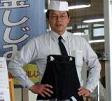Thursday, June 08, 2006
Yoroi 24
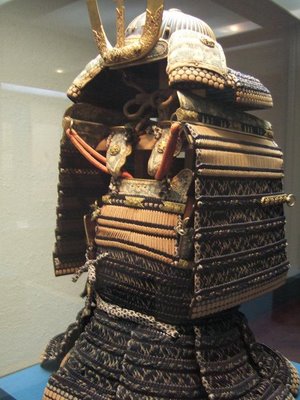
A domaru, a haramaki were used as armor of the utility in the Muromachi Period. A yoroi stopped being used by the actual fighting. A yoroi was used as a ceremony and the dedication goods. Warriors wore a domaru, a kabuto and sodes in the Muromachi Period. Roundness was put on the kabuto gradually. A kabuto fitted the head more by this improvement. Cloth was put inside the kabuto. This cloth is said as Ukebari. A kabuto became more comfortable by this. This form of kabuto is said as Akodanari-kabuto. The improvement to defend attack by the sword was given. It was spread without the hem of the shikoro hanging down. Therefore shikoros decreased from four steps to three steps. Then, Fukikaeshi became small. This form is said as Kasa-shikoro.
Wednesday, June 07, 2006
Yoroi 23
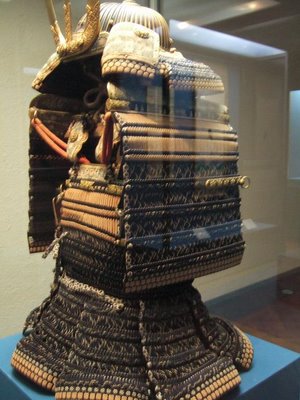
From the Nanbokucho Period, the Muromachi Period.
The Nanbokucho Period is 1392 from 1334. It tried to give splendid decoration until the early time of the Nanbokucho Period so that generals might make their existence outstanding. The armor was fitted with mach hardware which was given rich sculpture. They were fitted with the base of kuwagata, the right and left of the kabuto, the sodes, and so on. But, such ornamental hardware stops being used gradually. Hardware of the decoration isn't being used for the armor of the Nanbokucyo Period latter term. Then, that is a practical armor. Generals used a domaru and a haramaki in the battlefield. But, on the other hand, a yoroi was made as best. Or, a yoroi was offered in the shrine to pray for a victory. Therefore, many yorois of this age remain.
Monday, June 05, 2006
Yoroi 22
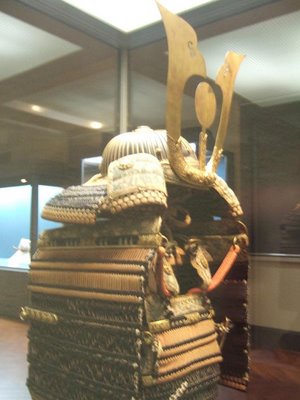
A domaru and a haramaki were used by generals preferably by using the sode with the kabuto together from the Kamakura Period end to the Muromachi Period. It is because wear was easy and then that was rational. The suji-kabuto comes to be used from about the Kamakura Period end. The kuwagata became a large size from the previous age. The base seat of the kuwagata was fastened with two rivets. The base seat is called Kikuza . A hoshi-kabuto used the head of the rivet as an ornament. A suji-kabuto was improved more sturdily. I think that this change is because the hand-to-hand combat increased. The kabuto which stood up to a direct hit such as a sword was necessary.
Sunday, June 04, 2006
Yoroi 21
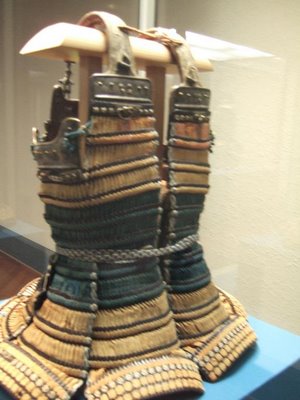
A haramaki was devised as a simpler armor. A haramaki is the armor that a hara-ate being used as a simple kit or the one for the infantryman in the Kamakura Period was improved. A hara-ate is the armor which protects the front of the trunk and the side. Three sheets of kusazuri were attached. In other words, a hara-ate is minimum kit. A haramaki which began to be used in the Kamakura Period defended a wider range. The kusazuri were increased in five sheets. The gap on the back of a haramaki was big. A samurai doesn't run away during the battle. In other words, the back is never turned to the enemy. Therefore, there is no problem. It could think about a haramaki like that. The kusazuri were increased in seven sheets in the Muromachi Period(1392~1573). Then, the part called Seita defended a gap on the back. The sode and the kabuto were attached, and a general was armed to the teeth.
Saturday, June 03, 2006
Yoroi 20
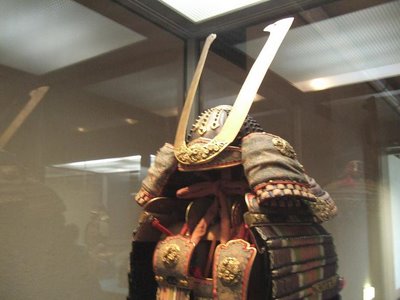
As for the kabuto, the number of boards called Hagi-ita increased. The rivet which a hagi-ita was fastened with became small, too, and then the number increased. The rivet of about 9 is being used for one line. There is a hole at the top of the kabuto. This is called Tehen-no-ana. A topknot was put in the tehen-no-ana, and a kabuto was put on as for the former generation. But, there was a problem. When a warrior bend his head, an arrow sometimes hit the hole at the time of the charge. So, a hole was made small. Then, A topknot was untied, and a kabuto was put on. Then, the tehen-no-ana became for the ventilation. The shikoro to protect a neck grew big gradually. This is to cope with the drastic movement of the hand-to-hand combat. And, warriors liked to put a kuwagata in front of the kabuto. A kuwagata is said as the form which imitated the leaf of Kuwai. The popular name of Kuwai is said as Kachigusa. That meaning is the grass of the victory.
Friday, June 02, 2006
Yoroi 19
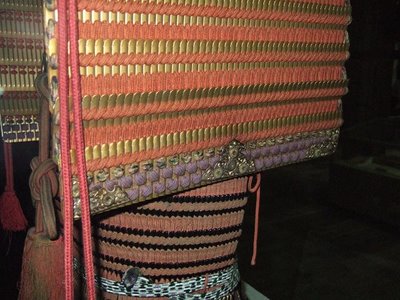
When it is compared with a previous age, the sane is narrow with a yoroi of the Kamakura Period. Length becomes short , too. The length of the yoroi became short by the sane was having become short, too. The weight of the yoroi was supported by tightening it with a part of the waist. There was a little pain by this improvement, and became easy to be active. A yarn became fine by the sane was becoming small, too. And, a yoroi had the exquisite impression. The sode were composed of 5-6 sheets of sane-ita in the Heian Period. It increased that a sode was composed of seven sheets in the Kamakura Period. I think that the size of a sane influences this change.
Thursday, June 01, 2006
Yoroi 18
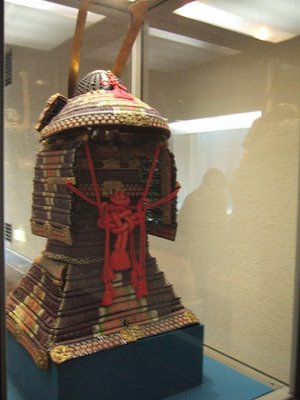
A battle style changed from the Heian Period to the Kamakura Period. And, a yoroi was improved, too. The length of the yoroi was long in the Heian Period , and the bottom edge of the trunk was around the hipbone. (A bottom edge is said as Hotte.) Therefore, it has the possibility to hurt a hipbone in case of riding. So, the hotte was widened, and put on the saddle, and then the weight of the yoroi was supported. But, there was a problem by the battle by walking. It was that a shoulder took all the weight of the yoroi. It was improved to ease that pain. The length of the yoroi was shortened, and the hotte wasn't widened. The yoroi fitted a body. Then, weight was received by tightening a waist with the string.
